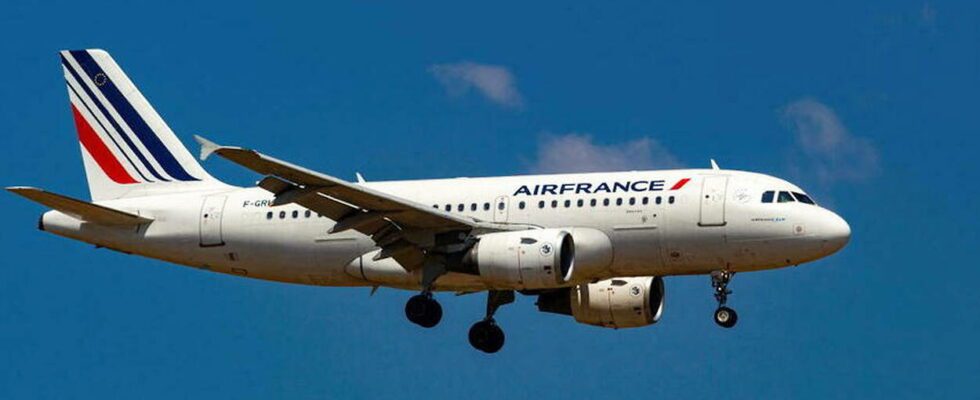Eanother law for nothing? On the Roissy airport departures board, there are many destinations that should no longer exist: Nantes, Lyon, Bordeaux… The climate law, adopted in 2021, nevertheless provided for the disappearance of domestic flights when there was an alternative by train. in less than 2.5 hours. A measure stemming from the citizens’ convention for the climate – even if its ambition has been revised downwards, the convention instead retaining a threshold of 4 hours of travel – which was to make it possible to reduce gas emissions greenhouse effect of air transport.
READ ALSOClimate convention: the quits or double of Emmanuel MacronA revolution proudly brandished by Emmanuel Macron as a witness to his ecological commitment. “It’s done,” hammered the president in a video posted on YouTube in mid-November. Two years after the adoption of the law, the implementing decree has still not been issued and these flights are still not prohibited. And above all, the government’s draft decree, validated by the European Commission, allows so many exceptions to the rule that most of the targeted flights will not disappear in the end. Explanations.
Only three out of eight lines prohibited
The measure will therefore only remove three lines, all departing from Paris-Orly, to Bordeaux, Lyon and Nantes. A saving of 55,000 tonnes of CO2, advances the Directorate General of Civil Aviation (DGAC). Compared to global traffic, the figure seems ridiculous: these flights represent only “0.3% of emissions from mainland France, or 3% of domestic emissions”, retorts Jo Dardenne, director of the aviation division of Transport & Environment, a lobbyist for the decarbonization of transport. A measure above all “symbolic, which will unfortunately have very little impact on emissions”.
READ ALSOClimate: can air transport reinvent itself in time? Especially since “these three prohibited lines were all at the end of their life”, breathes Paul Chiambaretto, professor of marketing and director of the Pégase chair at Montpellier Business School, specializing in the economics of air transport. “When an LGV line exists, air traffic naturally erodes. Only business customers and connecting passengers to long-haul flights remain, which Air France departs from Roissy instead, including, increasingly, overseas flights historically based at Orly.
Sleight of hand
As for the five other air links for which a TGV journey exists in less than 2 h 30, no ban is on the program. At the end of February, this represented around 300 flights per week between Paris-Charles-de-Gaulle (Roissy) and Lyon, Rennes, Nantes and Bordeaux, but also between Lyon and Marseille. A sleight of hand allowed by two derogations introduced in the draft decree.
The executive actually wanted to maintain flights to Roissy to allow connections with long-haul flights. But the European Commission rejected the idea which, in its view, created a distortion of competition between Air France and other companies not operating long-distance flights. The government has therefore decided to use the TGV station at the airport, located northeast of Paris, for the calculation of the train journey time, rather than relying on the journey between the city centers. And here is Bordeaux and Nantes more than 2 h 30 from the airport, justifying maintaining flights despite the LGV to Paris.
Finally, for Roissy-Rennes (2 h 30 by train), Roissy-Lyon (2 hours) and Lyon-Marseille (1 h 40), the State quite simply considered that the train timetables were not satisfactory enough to be considered as an alternative. The TGV “does not allow you to return to Lyon after the arrival of the last waves of long-haul” in Paris, justifies for example the DGAC in the public consultation carried out in December and January.
The last train from Roissy to Lyon-Saint-Exupéry (again, we have chosen the airport station) leaves at 4:40 p.m.; the last flight at 10:10 p.m. Even if you want to arrive in the center of Lyon, the last TGV leaves the airport at 8:39 p.m. An improvement in the service by the SNCF “with sufficient frequencies and satisfactory timetables could allow the prohibition of these air links”, assures the DGAC.
An absurd measure?
“This measure has been completely hijacked”, annoys William Aucant, former member of the citizens’ convention and since elected regional councilor of Pays de la Loire. “The State lacks courage and plays on terms to try to do as little as possible! A law so emptied of its substance that it becomes absurd, agrees Paul Chiambaretto. “We significantly degrade passenger comfort by removing these lines that some still need to ultimately save only a few tonnes of CO2…” Especially since the question of the price, which was part of the reflection of the citizens’ convention, “was completely evaded”, annoys the professor.
READ ALSOClimate: Emmanuel Macron, prince of symbols
“Even if the French measure is symbolic for the environment for the moment, it is politically important”, nuances Jo Dardenne, who sees it as a way of encouraging consumers to use less polluting alternatives to travel when they exist. The measure, as required by the European Union, will have to be reassessed two years after its entry into force. It is still necessary that the implementing decree be issued.
After two attempts to obtain the blank check from the European Commission in December, then the public consultation, the decree was finally submitted to the Council of State, indicates the entourage of the Minister of Transport, Clément Beaune. “The publication should therefore take place in April, subject to examination by the Council of State. In the meantime, the companies have themselves canceled the three routes in question. The other short flights still have a bright future ahead of them.
